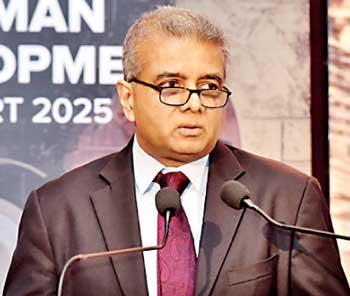
- Dr. Wijayasuriya says that in crafting Sri Lanka’s digital economy blueprint and roadmap, a whole-of-economy approach has been taken
- Asserts increasing ratio of digital economy to total GDP is key to driving growth momentum
- Says AI will reside at very epicentre of nation’s competitiveness, at very epicentre of economy

By Shabiya Ali Ahlam
Sri Lanka aims to grow its digital economy fivefold over the next five years, placing artificial intelligence (AI) at the centre of its strategy to boost growth, enhance inclusion and strengthen global competitiveness, a senior official said.
Chief Advisor to President on Digital Economy Dr. Hans Wijayasuriya said the country is working toward raising the contribution of its digital economy from an estimated 3-5 percent of GDP to 15 percent through an “AI-first” blueprint.
He was speaking at the launch of the United Nations Human Development Index (HDI) Report 2025, in Colombo. The theme of the report this year is ‘A Matter of Choice: People and Possibilities in the Age of AI’.
“In crafting Sri Lanka’s digital economy blueprint and roadmap, we have taken a whole-of-economy approach. So, it’s an overlapping ambition to use digital means to grow Sri Lanka’s economy, on the one hand, to accelerate growth and on the other hand, to uplift indices such as the HDI, inclusion indices, capability indices and very importantly, national competitiveness,” said Dr. Wijayasuriya.
“We are talking about data. We are talking about technologies like AI, about which we hear a lot this evening, technologies such as the internet of things, cloud and various other digital inputs and digital guides of economic growth and development,” he added. According to Dr. Wijayasuriya, increasing the ratio of the digital economy to total GDP is key to driving the growth momentum. As the nation grows this ratio from the low single digit to mid double digit, the propensity of the economic growth of the country to receive an update in the short to medium term also increases.
He outlined three tiers of digital economy development: from the basic enablers such as digital payments and ICT services, to platforms like e-commerce and finally to sector-wide integration, where digital tools are embedded across every industry — a stage he described as the most transformative.
The strongest and fastest driver of digital economic growth, he said, occurs when digital technologies deeply integrate across all industries. The widespread adoption of digital resources, especially in sectors like communication and healthcare, not only boosts employment but also cultivates globally relevant digital skills. He further highlighted AI as a critical catalyst in this transformation.
“When we talk about AI, (it is) one of the most incisive tools among all those digital tools, because AI, in fact, will reside at the very epicentre of the nation’s competitiveness, at the very epicentre of the economy. Those who adopt AI and use AI intelligently and inclusively will gain a competitive advantage.”
He also cautioned that the stakes are high, noting that the divide between those with access to AI and those without could deepen the existing inequalities.
However, he asserted that Sri Lanka begins this journey from a relatively strong foundation.
“We are already a high HDI nation and therefore, the guardrails that we need to put in place are from a position of strength, as opposed to some position of weakness. And also, the fact that our Gini coefficient or the inequality coefficient on a regional basis, is one of the best.”
Dr. Wijayasuriya emphasised that inclusion is the foremost priority and a foundational principle guiding the design and development of Sri Lanka’s digital economy. He stressed that this goes beyond mere digital access to ensuring meaningful participation and equitable benefits throughout the economy.
On the technology front, he reaffirmed that AI is a core principle underpinning the country’s digital strategy. The blueprint integrates AI across all layers of its infrastructure — both horizontal systems like digital public services and soft infrastructures that encompass government and private sector operations. He highlighted the ongoing initiatives such as the unique digital identity platform, national data exchange and data registries as key components of this framework. Additionally, AI-focused tools and models are being tailored for specific sectors, including healthcare, education and agriculture, to drive targeted innovation.
“AI is omnipresent throughout. But equally important is the fact that this blueprint is wrapped by a framework of governance and trust.”
“Legislation, institutional frameworks, safe AI, responsible application of AI and other digital technologies brought together with an overall trust environment, which engenders the use of AI by the population at large,” said Dr. Wijayasuriya.
Source : Daily News
Leave a Reply